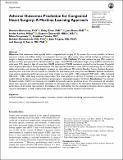Adverse Outcomes Prediction for Congenital Heart Surgery: A Machine Learning Approach
Author(s)
Bertsimas, Dimitris; Zhuo, Daisy; Dunn, Jack; Levine, Jordan; Zuccarelli, Eugenio; Smyrnakis, Nikos; Tobota, Zdzislaw; Maruszewski, Bohdan; Fragata, Jose; Sarris, George E; ... Show more Show less
DownloadAccepted version (305.2Kb)
Open Access Policy
Open Access Policy
Creative Commons Attribution-Noncommercial-Share Alike
Terms of use
Metadata
Show full item recordAbstract
<jats:sec><jats:title>Objective:</jats:title><jats:p> Risk assessment tools typically used in congenital heart surgery (CHS) assume that various possible risk factors interact in a linear and additive fashion, an assumption that may not reflect reality. Using artificial intelligence techniques, we sought to develop nonlinear models for predicting outcomes in CHS. </jats:p></jats:sec><jats:sec><jats:title>Methods:</jats:title><jats:p> We built machine learning (ML) models to predict mortality, postoperative mechanical ventilatory support time (MVST), and hospital length of stay (LOS) for patients who underwent CHS, based on data of more than 235,000 patients and 295,000 operations provided by the European Congenital Heart Surgeons Association Congenital Database. We used optimal classification trees (OCTs) methodology for its interpretability and accuracy, and compared to logistic regression and state-of-the-art ML methods (Random Forests, Gradient Boosting), reporting their area under the curve (AUC or c-statistic) for both training and testing data sets. </jats:p></jats:sec><jats:sec><jats:title>Results:</jats:title><jats:p> Optimal classification trees achieve outstanding performance across all three models (mortality AUC = 0.86, prolonged MVST AUC = 0.85, prolonged LOS AUC = 0.82), while being intuitively interpretable. The most significant predictors of mortality are procedure, age, and weight, followed by days since previous admission and any general preoperative patient risk factors. </jats:p></jats:sec><jats:sec><jats:title>Conclusions:</jats:title><jats:p> The nonlinear ML-based models of OCTs are intuitively interpretable and provide superior predictive power. The associated risk calculator allows easy, accurate, and understandable estimation of individual patient risks, in the theoretical framework of the average performance of all centers represented in the database. This methodology has the potential to facilitate decision-making and resource optimization in CHS, enabling total quality management and precise benchmarking initiatives. </jats:p></jats:sec>
Date issued
2021Department
Massachusetts Institute of Technology. Operations Research Center; Sloan School of ManagementJournal
World Journal for Pediatric and Congenital Heart Surgery
Publisher
SAGE Publications
Citation
Bertsimas, Dimitris, Zhuo, Daisy, Dunn, Jack, Levine, Jordan, Zuccarelli, Eugenio et al. 2021. "Adverse Outcomes Prediction for Congenital Heart Surgery: A Machine Learning Approach." World Journal for Pediatric and Congenital Heart Surgery, 12 (4).
Version: Author's final manuscript